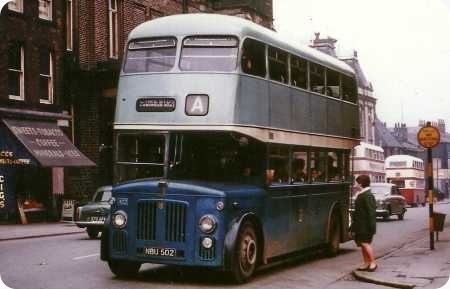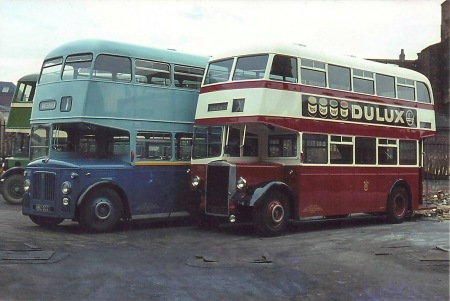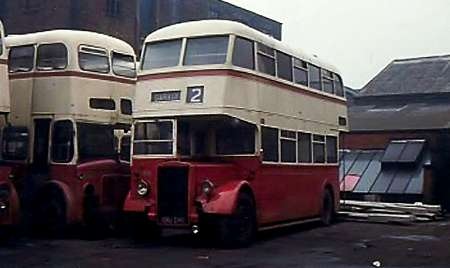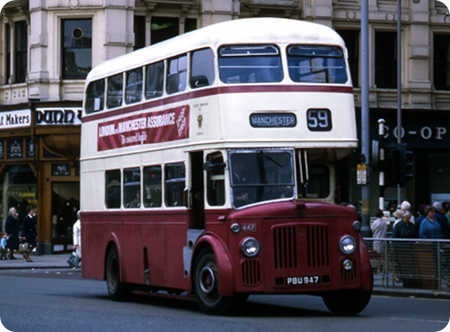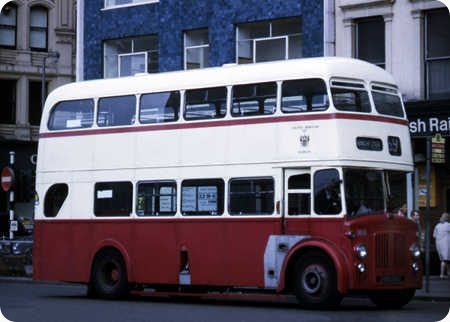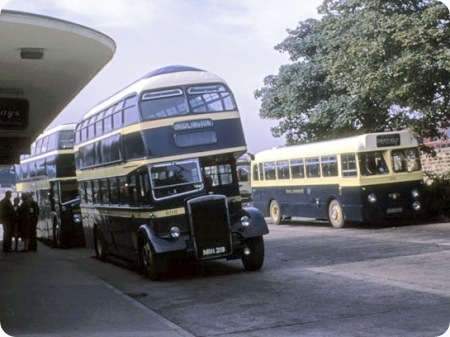
Copyright John Stringer
East Yorkshire Motor Services
1953
Leyland PD2/12
Roe HBB56R
Westwood Bus Station, Scarborough, photographed whilst on a family holiday in 1966.
In the foreground 1953 Roe-bodied Leyland PD2/12 608 (NRH 219) is loading passengers for Bridlington, whilst behind lurks 1963 front-entrance Bridgemaster 749 (3749 RH). Opposite, laying over before snarling its way to Driffield, is 1960 Metro-Cammell-bodied Tiger Cub 689 (6689 KH).
What would Health & Safety officialdom make nowadays of buses loading passengers whilst parked with their off sides against the platforms, I wonder?
608 was withdrawn in 1969, and 749 in 1976 – both passing to North’s, the dealer, and later for scrap.
689 was withdrawn in 1972 and fared a little better, being sold on by North’s along with the rest of the batch to Irish operator Sureline of Lurgan.
Happy Days! Now where did I park my time-machine?
Photograph and Copy contributed by John Stringer
05/04/12 – 06:50
Your comment about buses loading with their off sides against the platforms reminds me of Lower Mosley Street Bus Station in Manchester. In particular I remember the evening rush hour, when elderly North Western Atkinsons (inter alia) which had been sitting in the depot all day, would sit there with their smoky exhausts blowing straight into a waiting room full of people.
Peter Williamson
05/04/12 – 09:26
The ordeal of waiting passengers being nearly asphyxiated by exhaust fumes is by no means confined to bus stations these days – since the widespread adoption of one way streets the same experience can now be freely enjoyed in most towns and cities, especially when traffic is at a standstill in peak periods.
Chris Youhill
05/04/12 – 09:28
Oh, John, please leave room for me in your time machine! In fact, it would be best if it could take the form of a Beverly Bar ‘decker, (or even a fleet of them), to make room for all the readers of this site who would want to join you. (Bags me a seat upstairs).
Loading offside parked buses was hardly the best arrangement, and I guess there must have been accidents, but all the staff would have known the potential for them and would have been sensible enough to take proper care, I’m sure. On the question of exhaust fumes, (Peter Ws comment), we rarely used the Westwood Bus Station, but the joy, as a lad, of drinking in EY diesel fumes at Bridlington bus station, (especially after a shower), is one of my most cherished childhood memories.
Roy Burke
Myriad were the diesel flavoured Bus Station/Depots in the Heyday. Without thinking – Kingston LT; Brixham (and other) Devon General. (Name your own).
I have a great love for the Yorkshire Coast – especially Scarborough – and agree that indigo and primrose rules, but give me STD cream and blue, SUT red and grey and CCT green and cream. I may be prejudiced, but I will keep the flag flying for South Yorkshire and North Derbyshire. [NB, I’m too young to remember classic EMMS livery!]
David Oldfield
05/04/12 – 18:11
It always struck me that bus station bays from which buses have to reverse out (standard these days) represent a far more hazardous arrangement than the drive through type. Strange that it’s allowed, bearing in mind that reversing a bus at all seems to be frowned upon everywhere else. Mounting a back-loader from a pavement on wrong side wasn’t really a big deal, provided the conductor kept watch. Yes please, save me a place too John – front nearside downstairs if possible – a good balance of view ahead and aural delight.
Stephen Ford
05/04/12 – 18:13
Gentlemen.. please may I have a seat on your time machine? I share your memories of the "aroma" of diesel fumes which always signalled the start of another adventure..a ride on a a previously unseen bus to tick off in my Ian Allan book was the best! A warm, sunny day gave the best effect.
Then I also fondly recall the excitement of riding on brand new, first day out Bristol KSW/Lodekka’s etc…the inside filled with the scent of new paint, new upholstery and sometimes the engine was still "running in" so emitted thin blue smoke from the exhaust to confirm it was Brand New! Upstairs so clean and bright before being ruined by a million Woodbines..my mother would never ride upstairs except when the bus was new or freshly repainted.
It’s drifting from the subject but John’s simple picture brings back lots of memories from 1966. Thank you.
Richard Leaman
06/04/12 – 07:39
Re my posting under the recent Hebble Photo and offside loading – I hadn’t considered the exhaust fumes – however I suppose it softened us all up for the top deck smokers’ fug !
Farmer G
06/04/12 – 07:40
As a conductor and driver on EYMS in 1966/7 we normally arrived 30mins before departure then went across road for a cuppa only to arrive back at the bus to find it had magically filled with passengers and yes the platform was way high when parked that way. However in 1967 they got us to park the other way round much better for the passengers but the driver had a hard pull right back onto the road no power steering in them days, but very enjoyable days
Ken Wragg
06/04/12 – 07:41
John
What a superb photograph!
One question – 608 appears to have a raised advert panel between the two upper cream bands; was it a very early illuminated advert?
Bob Gell
06/04/12 – 07:41
Comments about exhaust fumes reminds me of as a teenager in the 40s and early 50s in Killermont Street bus station in Glasgow waiting for the East Kilbride 70 or 71 Central SMT, being subjected to the fumes of the Edinburgh SMT`s elderly TD5s in the next platform.
Jim Hepburn
06/04/12 – 07:42
I’m in complete agreement with Stephen Ford about bus stations which require reversing movements to exit. I don’t think this model has to be adhered to because South Yorkshire PTE, to it’s everlasting credit, has built excellent drive through stations at Sheffield, Meadowhall, Rotherham and Doncaster. In Derby, the City Council has provided a reverse off bus station which is perhaps the worst example of it’s kind in England. The vehicle area is insufficient which causes conflicting movements and vehicles entering are continually blocked by those trying to exit. There have been many minor scrapes since it opened but it’s new and therefore criticism is not allowed!
Chris Barker
06/04/12 – 09:25
I agree wholeheartedly with Stephen Ford and Chris B – if I had my way "reversing off the stand" bus stations would be banished. The "state of the art" one in Leeds has been the scene of many disasters since it opened some twenty years ago. The tiny one in Otley is similarly hazardous. I have personally experienced years of difficulty in the Leeds one, where our stands 5/6 had appalling lack of available view when reversing on left lock – fast incoming vehicles (speed limit routinely ignored by many) could easily disappear from view as they swept through a right hand near U turn.
Another really unbelievable feature is that intending passengers sit or stand in their admittedly comfy concourse behind glass windows just waiting for an out of control vehicle to ram the frontage – this has happened at least twice in Leeds, and the subsequently installed "crash bars" would be of limited effect in a serious case.
Chris Youhill
06/04/12 – 15:27
Chris Y, this brings to mind the mutually known, erstwhile Vicar Lane bus station in Leeds, where West Yorkshire and Samuel Ledgard used to perform similar reversals. However, the fundamental difference was the presence of the conductor on the back platform giving two resounding blasts of his/her Acme Thunderer to signal "all’s well". Not a guarantee of safety, of course, as passengers would often invade the road space to make a last minute jump onto the bus.
Paul Haywood
06/04/12 – 15:28
For those who relish the Scarborough Scene in the relatively recent past, there are some cracking photos to be found at the following link //www.focustransport.org.uk
John Darwent
06/04/12 – 15:28
The Wakefield one is just the same, Chris Y. It has always reminded me of that famous scene out of "Airplane". They need proper buffers!
Reverting to smells- not the smell of exhaust, but hot engines: a Daimler CVD6 at North Bridge in Doncaster with its engine side access open (as often) & oil everywhere- a sweet smell which was almost intoxicating… and talking of North Bridge, the drivers had (as I have said before) to thread their way through to the exit and then perform a u-turn across the old A1!
Joe
07/04/12 – 07:04
Yes Paul, I remember very well the entertaining presentations at Vicar LANE – the low wall adjoining the street was hit so often that it was eventually replaced by simple columns and "draped" chains. At certain "ad hoc" times a spare conductor would be around to help in reversing One man/lady buses off the stands.
One priceless experience must be related here. Within days of the Ledgard takeover an elderly former Yeadon (Moorfield) Depot driver was having as much trouble persuading his unfamiliar (and detested by him) Bristol Lodekka in going backwards as he’d had in encouraging it forwards between Otley and Leeds. He was a comical raconteur, and given to priceless dramatic exaggerations, and told us of this encounter with authority :-
JY – "I were just revussin’ off t’ stand when a yappy little ****** in a shiny ‘at rapped on t’ mudguard and snapped "I want thy number !!"
"Oh, sez I, and why the (censored) duz tha’ want my number." "Tha’s just knocked wall down sez ‘e." "Oh ‘av a ?? – says I, well I’d just like thee to tell us this – If I’ve knocked thi’ wall down, wot wer that long ‘aired **** at back wi’ t’ whistle doooin’ ?"
Chris Youhill
07/04/12 – 07:05
East Yorkshire’s Westwood bus station was a charming place made even more captivating by the company’s blue/cream/white buses (and the trips to visit my two great-aunts in Cayton who incidentally would never use the competing services of United unless they absolutely had to!!). The site is now a Tesco store.
Ken Wragg mentions that in 1967 loading at Westwood was changed from the format shown in the photo so that bus doors were then against the platform. I recall in that, in the earlier part of the 1960s, the buses loaded this way (with their doors against the platform) so for some reason a change was made and subsequently changed back.
The site was perched on the edge of the ground falling away towards a large school and, as can be seen in the photograph, the loading area sloped. To the left of the building there was a narrower strip of concreted parking road at a lower level than that seen in the photo.
David Slater
07/04/12 – 07:07
I guess Chris Y will have worked at some time on the S.Ledgard Bradford – Harrogate route. Doubtless he will remember the reversing routine in Menston Village. The Bus would turn right into Burley Lane and then the conductor would dismount and check the crossroads was clear – give two blasts on his Acme Thunderer and watch the bus back round the blind corner – jump back on and the bus would pull in to the stop in front of the shops. If I recall it was at 10 minutes past from Harrogate and 40 minutes past from Bradford.
Gordon Green
07/04/12 – 15:42
Interesting recollections indeed Gordon and I worked at Otley depot so our only participation in the Bradford – Harrogate service consisted of two Monday to Friday "Workmen’s" duplicates. The morning one was at 07:20 from Menston to Otley and at teatime 17:33 from Otley to White Cross. The Menston Village reversing that you mention was of course involved in both cases. The main Bradford to Harrogate service (the Company’s longest route) was operated entirely by Bradford depot and had been inherited from B & B Tours – to the very end of Ledgard’s it remained referred to by staff and passengers as "The B & B" – but officially within the Company after the founder’s death in 1952 as S.Ledgard (Bradford) Ltd. Departure times were actually 10 past the hour from Bradford, and 30 minutes past from Harrogate. Our lowly position in the order of things in the mighty West Yorkshire Road Car empire was made clear in Harrogate Bus Station – we departed from a different stop to the West Yorkshire number 53 service, our stand being labelled "Bradford – S.Ledgard." Perhaps this was a little chagrin from the WY as we were the only ones to serve Menston Village in its entirety.
Chris Youhill
07/04/12 – 15:48
The talk of odd loading procedures reminds me of Brighton’s Pool Valley bus station where vehicles were reversed on to the stands, fine with back loaders but with the advent of front or forward entrances passengers had to walk on the roadway and negotiate the steps from there. The reversing was supervised by conductors while such existed, after the advent of OMO ex conductors were employed to supervise these manoeuvres which ensured accidents were few and far between. The whole bus station was in fact a public road open to other vehicles also buses travelling west had to cross the very busy main promenade difficult in the summer season, especially with a PD3 Queen Mary with the numerous blind spots resulting from their full fronts. I feel somewhat of a lone voice for the south of the country on the site but thoroughly enjoy the chatter and the shared knowledge that is available so easily.
Diesel Dave
07/04/12 – 17:59
Chris Y – the times I quoted were in fact the Menston times – from Bradford the Ledgard at 10 mins past completed a 15 min afternoon service from Bradford to Harrogate – Service 53 via Otley at 25 and 55 and Service 51 via Yeadon Moor at 40 plus short workings to Otley on the 53 at 05 and 40. In addition there was the 50 Otley via Yeadon hourly at 10 mins past ! These days you are hard pressed to find a bus from Menston to Bradford as I found out recently when leaving my car for service.
Believe it or not there was also an hourly 76 Harrogate – Skipton between Otley and Harrogate.
You beat me to it with the banishment in Harrogate Bus Station – about half way down amongst Wetherby’s I recall. However SL were permitted use of the Harrogate stand at Chester Street next to the Green Hut – for about 2 minutes before departure !
One final bit of memorabilia – there was for many years an abandoned red B & B Tours timetable case fixed to the wall on the Bradford bound side of the road at Lister Park Gates at the bottom of Oak Lane – it was certainly there in the 1950’s and possibly longer.
Farmer G
08/04/12 – 06:42
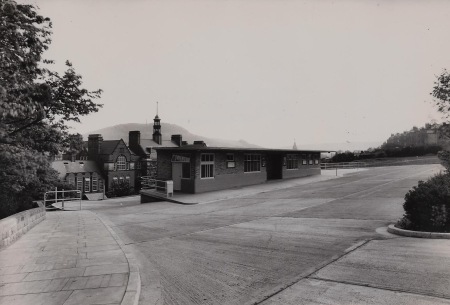

All this talk about Westwood bus station in Scarborough, reminded me about some official photographs I have when it was first opened, you can tell from these, that it was built on a slope.
Also of interest regarding this bus station was the use of EYMS’s 653 DBT553, 541 LAT69 & 674 VKH674 over the years, in use as left luggage stores, parked on the lower part of the slope.
Mike Davies
08/04/12 – 06:46
Your ‘priceless’ story, Chris Y, reminds me of my square-bashing time at RAF West Kirby (Wirral). We had a lad there who lived in Huddersfield and would, in his parlance, "…go over yon t’Pennines in t’cooch.’ whenever he was able to!
And, Diesel Dave, you are not alone and I do recall Pool Valley on my occasional visits from Southsea to Brighton, on one occasion on a Leyland PD2/Beadle, lovely buses.
Chris Hebbron
08/04/12 – 10:59
More fascinating memories Farmer G. I have to confess that I’d no idea of the extremely even intervals scheduled from Bradford on the various services. Interestingly, the 50 service was also integrated in a similar manner with Samuel Ledgard at the Otley end. The West Yorkshire 50 service left at 05 past the hour while the Ledgard buses (Yeadon Depot, the Moorfield) left Otley at 25 past (via White Cross) and 45 past via The Chevin, thereby providing an even twenty minute interval service between Otley, Guiseley, Yeadon and Rawdon.
I had a wry chuckle when you wrote "Believe it or not" about the 76 service from Otley to Harrogate. When I worked at West Yorkshire’s Ilkley depot the 76 was my favourite route and I swapped to be on there when ever possible. It was a magnificent five hour round trip from Skipton via Ilkley, Otley, Harrogate, Wetherby, and Boston Spa to Tadcaster. So enjoyable was the delightful country journey that one felt guilty, well almost !!, at being paid for the ride. It was also moderately to extremely busy and was therefore no shrinking violet in the revenue stakes. Five "cars" were required for the hourly service, these being provided in varying proportions by Skipton, Ilkley, Harrogate and Wetherby depots – on one weekday journey the Skipton depot car was operated by a Grassington depot crew – I daresay with Ordnance Survey map to assist with their brave foray into the big wide World !!
I don’t unfortunately remember the B & B timetable case at Oak Lane – if I had I think I may have been willing to risk an appearance before the Bradford Bench in order to acquire and hide such a priceless artefact by night.
Chris Youhill
08/04/12 – 11:00
Your comments on Pool Valley, Diesel Dave and Chris H brought back a few memories, because I was Traffic Superintendent, Brighton, in 1968.
You are absolutely right, Dave about the confusing relationship between the bus station and the adjoining public roads. Southdown did not own any part of the road way, and control over the area reserved for buses was most strictly exercised by traffic wardens.
I once received a very strong warning from a traffic warden when I was at Pool Valley on business and briefly parked a Southdown traffic car, (a Morris 1100), in the far left bus aisle. Well, one of our 1100s had a PSV licence, so we could carry passengers in it, (e.g for missed express services etc). Being the arrogant and cocky so-and-so I then was, I made sure that the next time I wanted to park a company car at Pool Valley for a few minutes I used that particular car, and that the same traffic warden was on duty. As the guy walked up to me, I gained immense glee by saying to him as I swept past, ‘Before you start, mate, that’s a bus. If you don’t believe me, look in the window.’ Stupid and immature, no doubt, but it made my day – a rare event for me at Southdown.
Roy Burke
08/04/12 – 16:12
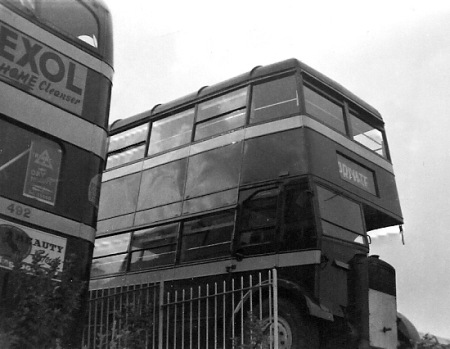
I knew this 1959 photo might come in useful eventually. Apologies for the poor quality and alignment (missing the registration number etc) but I presume this is DBT 553 acting as a Left Luggage Office referred to by Mike Davies. I must have climbed down into the garden of the then Boys’ High School (in 1976 becoming the Stephen Joseph Theatre where Alan Ayckborne would premier many of his famous comedy plays, before they moved to the present Odeon theatre site).
Paul Haywood
11/04/12 – 15:43
Maybe I’m a bit over sensitive, but I think that inadvertently I may have done myself a minor disservice in my previous comment, in an attempt to keep the comment short.
I wouldn’t want to imply that parking company cars in the bus aisles at Pool Valley, (by me or anyone else for that mater), was a commonplace activity; quite the opposite. It was a rare event that happened only for urgent reasons, and then for a very short time. Controlling traffic around and in the bus station was vital, and we appreciated the efforts of the traffic wardens, who kindly allowed our temporary parking because they knew we’d be involved in keeping the buses running, and didn’t abuse the latitude they gave us.
Similarly, instead my phrase that I ‘made sure’ that the same guy who’d chewed me off previously was on duty again, perhaps I should have said that I’d seen he was on duty when I was at Pool Valley earlier that day, and although I did deliberately use the car with the PSV licence, that was only because both 1100s were available. I may have been stupid and immature, but I wasn’t, I think, downright cretinous.
Roy Burke
16/04/12 – 07:27
I’m going to stick up for "drive-in, reverse-out" bus stations. Provided pedestrians are kept well away from the reversing area, this layout provides much better passenger facilities, which can be concentrated in a single concourse. This also helps personal security, especially at night, and, more important, passengers do not have to cross busways to reach their bus on a separate island.
Compare Burnley, Leeds, Huddersfield and Wakefield with Wigan, Bolton, Bury and Rochdale. Someone got run over not long ago in Bury while crossing between buses. I also recall a fatality in Worcester bus station, another of the drive-through type, when a driver was run over.
Geoff Kerr
03/05/12 – 09:21
Just a follow up to Scarborough bus stations, I have sent some photos of the the three EYMS buses used as left luggage stores at Westwood bus station.
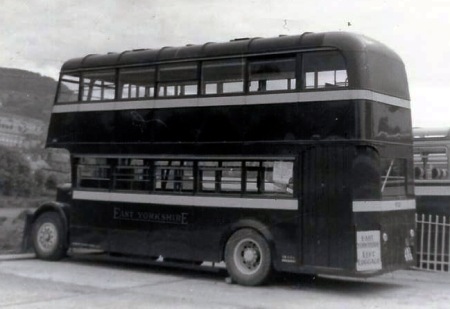
653 – DBT 553 was the first and was in use as a luggage store from 2/57 until 11/65 when it passed to Colbro (dealer) for scrap.
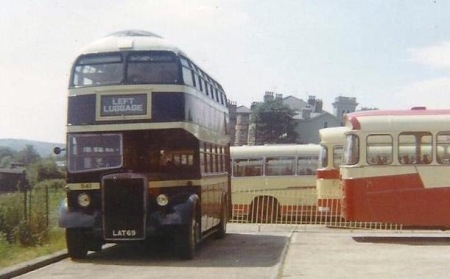
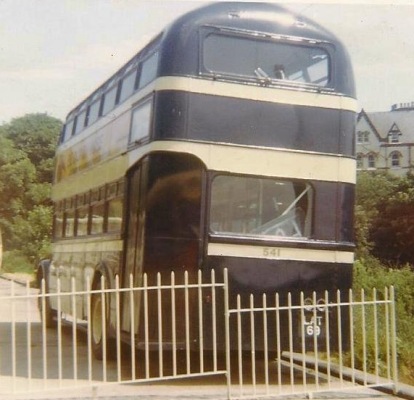
541 – LAT 69 was next replacing 653 in 1/66, 541 passed to United AC 3/72 when they took control of Westwood and continued as a luggage store until being sold for preservation 1/75 it still survives today, but in store somewhere local.
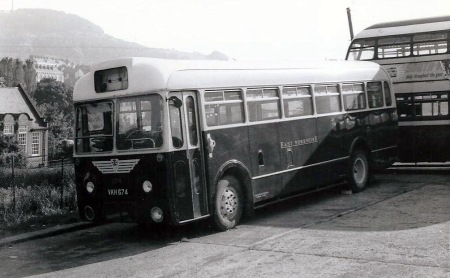
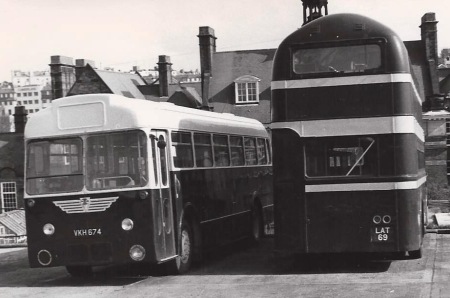
674 – VKH 674 was used next, along side 541, being converted in 7/69, this also passed to United ownership with the bus station in 3/72 and was in use until 1/75 when it passed into preservation, and was a well known vehicle at many rallies around the country, it is now in store along with 541 both out of use.
All three vehicles had their seats removed and wooden luggage racks fitted , 541 also had doors fitted on the platform area.
Mike Davies
13/08/14 – 14:43
I hope I’m not repeating something someone else has commented on but as a school girl, I travelled to Beverley High school from Hessle. The buses were navy and cream and had, so I was told, a specially domed roof so that they could get through Beverley Bar. For the most of my school life we caught a bus at 9 am arriving in Beverley around 9.40, missing Assembly! Apparently this was because there were not enough buses to go round at 8 am.
I am currently watching the documentary on EYMS and am delighted with the series, especially as I watched Rodney Hebden who was a great friend of my brother.
We all loved the livery colour and wondered why and when it changed to its modern day colours.
Meg
22/09/14 – 07:30
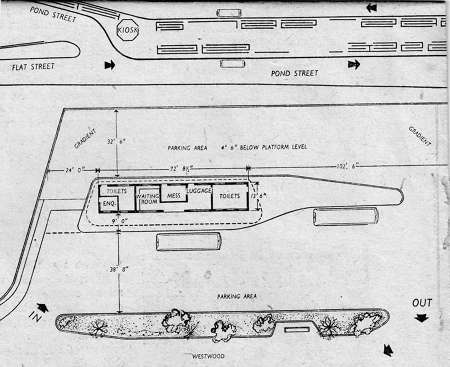
I came across an article in the Commercial Motor in April 1957 which has a description of the bus station.
It states it was designed mainly for holiday traffic being used by four services during the year. the Hull service jumps from hourly to half-hourly in summer and has extensive duplication. (as a schoolboy traveller to relatives outside Scarborough at Newby, I can vouch for that).
On a peak Saturday in summer 1956 there were 81 vehicle departures, 52 being duplicates on this service alone! The other services had 22 departures, 7 being duplicates.
Therefore the design provided more parking space than is usual. It is formed by two concreted areas at different levels with a concrete access ramp at each end, the lower level being exclusively for parking.
Passengers are picked up at two points on a single platform. facilities include a waiting room, inquiry and left luggage offices, staff rest rooms and toilets. A reinforced concrete canopy extends over the platform. So many buses in blue and primrose – if only we had digital cameras inn those days.
Malcolm J Wells
 Vehicle reminder shot for this posting
Vehicle reminder shot for this posting
21/10/16 – 07:20
John Stringer mentions the horror today’s Health & Safety people would have with offside loading/unloading in bus stations. They’d have a heart attack with the forecourt at Morden Tube Terminus. No better than a large supermarket carpark, with most queues forming behind concrete base "permanent" temporary bus stops, these huge queues had no protection from errant approaching buses as a result of driver carelessness or vehicle faults. Yet, I’m not aware of any accidents ever at this place of heaving humanity!
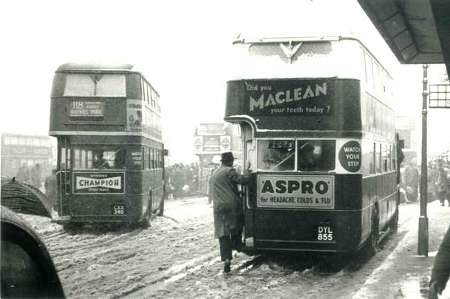
This photo illustrates the frequent shortage of London Transport’s lowbridge buses to serve the two red routes in Central Area, the 230 and 127. Here, 17-mile-distant Godstone Garage’s displaced-by-RLH’s green lowbridge STL2229, shows its wartime origins with the lack of a rear blind display indicator. On a foul 29 Mar 52, it is working from Central Area’s Merton Garage, on the 127 at Morden Tube Station forecourt. (the route plate stencil is visible on the back window), with STL1630 on the 118 and an RT on the 93. Photo by a probably frozen Alan Cross.
Chris Hebbron
22/10/16 – 09:42
Chris H’s description of the conditions at Morden Station reminds me of the abominable Wellington Street Coach Station in Leeds. Particularly as vehicle sizes grew its area was woefully inadequate. At one time there was no shelter but eventually an enclosed concrete alley was built across the full rear wall – any mechanical failure or driver misjudgement would have meant the victims within would have been crushed and showered with concrete and glass – mercifully this never happened. Meanwhile in the main open area – no bus lanes, just a terrifying "free for all", hundreds of passengers waited to load and alight while inspectors brusquely ordered them to "get back." Its closure couldn’t come soon enough.
Chris Youhill
